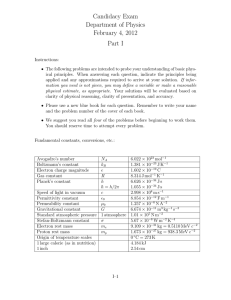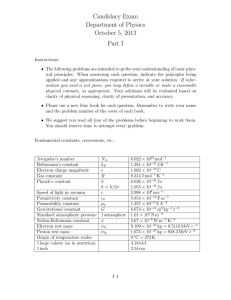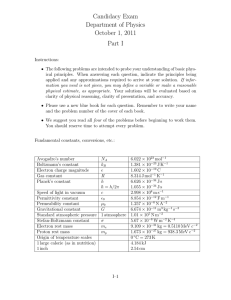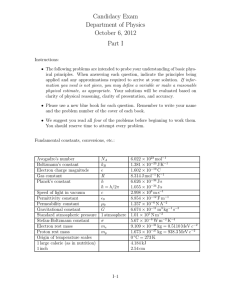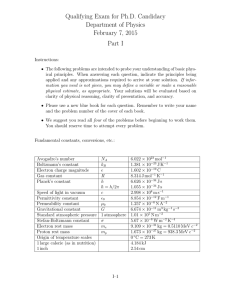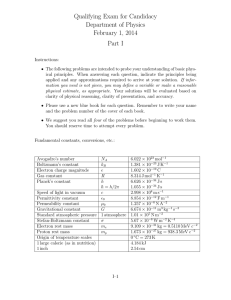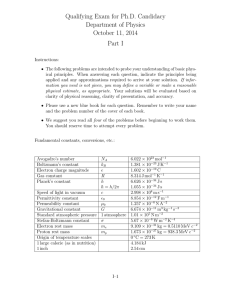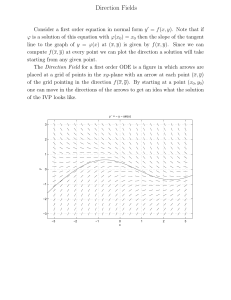Qualifying Exam for Ph.D. Candidacy Department of Physics February 2nd, 2013 Part I
advertisement
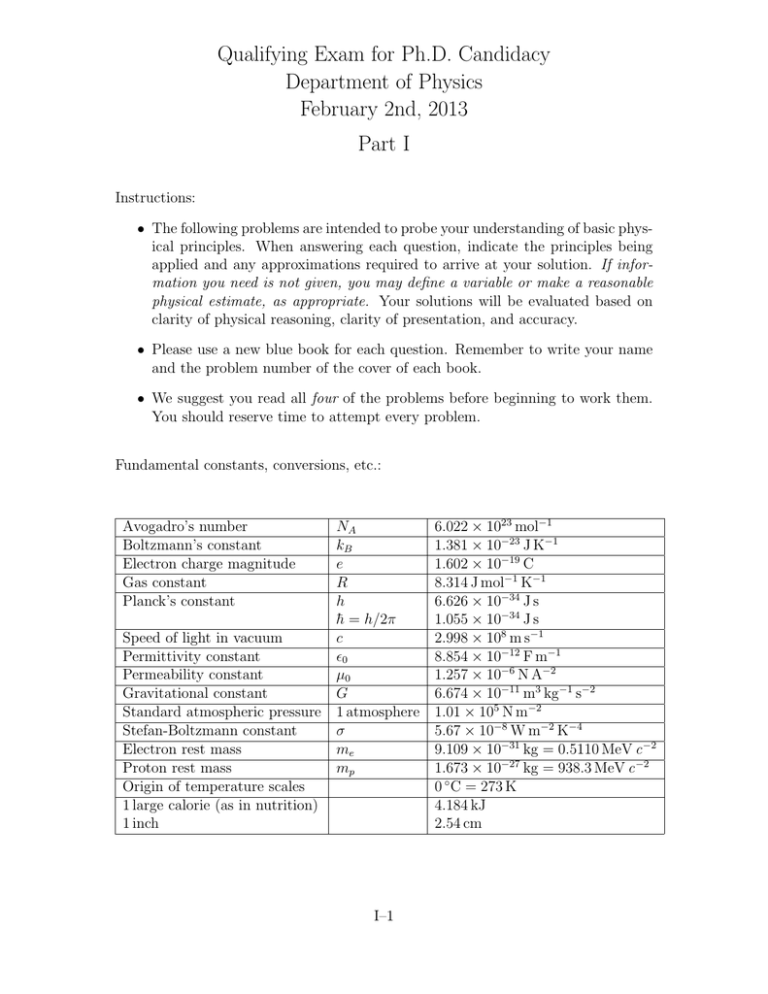
Qualifying Exam for Ph.D. Candidacy Department of Physics February 2nd, 2013 Part I Instructions: • The following problems are intended to probe your understanding of basic physical principles. When answering each question, indicate the principles being applied and any approximations required to arrive at your solution. If information you need is not given, you may define a variable or make a reasonable physical estimate, as appropriate. Your solutions will be evaluated based on clarity of physical reasoning, clarity of presentation, and accuracy. • Please use a new blue book for each question. Remember to write your name and the problem number of the cover of each book. • We suggest you read all four of the problems before beginning to work them. You should reserve time to attempt every problem. Fundamental constants, conversions, etc.: Avogadro’s number Boltzmann’s constant Electron charge magnitude Gas constant Planck’s constant NA kB e R h h̄ = h/2π Speed of light in vacuum c Permittivity constant 0 Permeability constant µ0 Gravitational constant G Standard atmospheric pressure 1 atmosphere Stefan-Boltzmann constant σ Electron rest mass me Proton rest mass mp Origin of temperature scales 1 large calorie (as in nutrition) 1 inch I–1 6.022 × 1023 mol−1 1.381 × 10−23 J K−1 1.602 × 10−19 C 8.314 J mol−1 K−1 6.626 × 10−34 J s 1.055 × 10−34 J s 2.998 × 108 m s−1 8.854 × 10−12 F m−1 1.257 × 10−6 N A−2 6.674 × 10−11 m3 kg−1 s−2 1.01 × 105 N m−2 5.67 × 10−8 W m−2 K−4 9.109 × 10−31 kg = 0.5110 MeV c −2 1.673 × 10−27 kg = 938.3 MeV c −2 0 ◦ C = 273 K 4.184 kJ 2.54 cm Definite integrals: Z ∞ −x2 e Z 0 ∞ √ π dx = . 2 xn e−x dx = Γ(n + 1) = n!. (I–1) (I–2) 0 Laplacian in spherical polar coordinates (r, θ, φ): 1 ∂ 1 ∂ ∂f 1 ∂ 2f 2 2 ∂f ∇f= 2 r + 2 sin θ + 2 2 . r ∂r ∂r r sin θ ∂θ ∂θ r sin θ ∂φ2 Laplacian in cylindrical coordinates (r, θ, z): ∂f 1 ∂ 2f 1 ∂ ∂ 2f 2 r + 2 2 + 2. ∇f= r ∂r ∂r r ∂θ ∂z (I–3) (I–4) I–1. Initially a rigid bar is suspended by vertical inextensible light strings at its ends, so that the bar is horizontal: L The bar is of length L, its mass m is uniformly distributed along its length, and its width is negligible. (a) Find the moment of inertia of the bar about its center and about its end. (b) The string on the right is cut: Find the tension in the remaining string very shortly after the other string is cut. I–2. Consider a system of two spin-1/2 particles interacting through the Hamitonian H = A(Sx2 − Sy2 ) + BSz2 , (I–5) where A and B are constants and Sx , Sy and Sz are the three components of the total spin of the system. Find the energy spectrum and the corresponding eigenvectors. I–2 I–3. A plane-parallel 15nF capacitor is connected across 70V battery. How much work must be done to double the plate separation (a) with the battery connected? (b) with the battery disconnected? I–4. A box of volume V0 has a small hole of area A0 . The box initially has one mole of an ideal gas at t = 0, which is at an initial temperature T (t = 0). Find the rate of energy flow through the hole as a function of temperature and other parameters. I–3 Qualifying Exam for Ph.D. Candidacy Department of Physics February 2nd, 2013 Part II Instructions: • The following problems are intended to probe your understanding of basic physical principles. When answering each question, indicate the principles being applied and any approximations required to arrive at your solution. If information you need is not given, you may define a variable or make a reasonable physical estimate, as appropriate. Your solutions will be evaluated based on clarity of physical reasoning, clarity of presentation, and accuracy. • Please use a new blue book for each question. Remember to write your name and the problem number of the cover of each book. • We suggest you read all four of the problems before beginning to work them. You should reserve time to attempt every problem. Fundamental constants, conversions, etc.: Avogadro’s number Boltzmann’s constant Electron charge magnitude Gas constant Planck’s constant NA kB e R h h̄ = h/2π Speed of light in vacuum c Permittivity constant 0 Permeability constant µ0 Gravitational constant G Standard atmospheric pressure 1 atmosphere Stefan-Boltzmann constant σ Electron rest mass me Proton rest mass mp Origin of temperature scales 1 large calorie (as in nutrition) 1 inch II–1 6.022 × 1023 mol−1 1.381 × 10−23 J K−1 1.602 × 10−19 C 8.314 J mol−1 K−1 6.626 × 10−34 J s 1.055 × 10−34 J s 2.998 × 108 m s−1 8.854 × 10−12 F m−1 1.257 × 10−6 N A−2 6.674 × 10−11 m3 kg−1 s−2 1.01 × 105 N m−2 5.67 × 10−8 W m−2 K−4 9.109 × 10−31 kg = 0.5110 MeV c −2 1.673 × 10−27 kg = 938.3 MeV c −2 0 ◦ C = 273 K 4.184 kJ 2.54 cm Definite integrals: Z ∞ −x2 e Z 0 ∞ √ π dx = . 2 xn e−x dx = Γ(n + 1) = n!. (II–1) (II–2) 0 Laplacian in spherical polar coordinates (r, θ, φ): 1 ∂ 1 ∂ ∂f 1 ∂ 2f 2 2 ∂f ∇f= 2 r + 2 sin θ + 2 2 . r ∂r ∂r r sin θ ∂θ ∂θ r sin θ ∂φ2 Laplacian in cylindrical coordinates (r, θ, z): 1 ∂ ∂f 1 ∂ 2f ∂ 2f 2 ∇f= r + 2 2 + 2. r ∂r ∂r r ∂θ ∂z (II–3) (II–4) II–1. Consider a particle that can move freely along a circular hoop that rotates about a vertical axis with angular velocity Ω. The radius of the hoop is R. (a) Find the Lagrangian. (b) Find the equations of motion and determine the equilibrium position(s) of the particle. (c) Determine which of the equilibrium position(s) is stable, and under what conditions. Ω II–2. A particle of mass m is confined to a one-dimensional region 0 ≤ x ≤ a. At time t = 0, its normalized wave function is r 32 1 2πx 2πx ψ(x, t = 0) = 1 + cos sin . (II–5) 17a 2 a a II–2 (a) Obtain the wave function at a later time t = t0 . (b) Find the average energy at t = 0 and at t = t0 . (c) Obtain the probability that at t = t0 , the particle is found in the left quarter of the region, i.e., in 0 ≤ x ≤ a/4. II–3. Consider a grounded conducting sphere of radius R. A point-like electric dipole of moment p is placed at distance a > R from the center of the sphere. The dipole is oriented along the radial direction. Find the induced charge distribution on the surface of the sphere. II–4. Assume that the earth and the sun are perfect black bodies. (a) How much energy does the sun radiate in Watts? (b) What fraction of the sun’s radiation is captured by the earth? (c) What is the earth’s intake of radiation energy from the sun? (d) Assume that the energy intake from the sun equals the energy radiated by the earth. Then derive the average temperature at the surface of the earth. Apart from constants included in the table of fundamental constants, other constants you may need are: • Radius of earth is RE = 6380 km • Radius of sun is RS = 7.0 × 108 m • Sun-earth separation is RSE = 1.5 × 1011 m • Sun’s surface temperature is TS = 6230 K II–3
